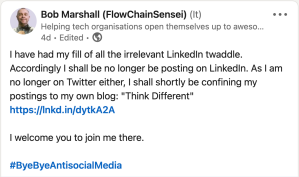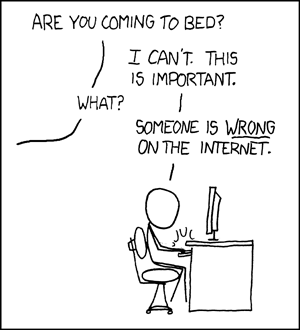A Quick Guide to Getting the Best Out of the Think Different Blog
For new and occasional readers, here’s a quick guide to this blog:
Intended Audience
Via this blog, I share insights of particular interest to CxOs, other senior business and technical managers, and development folks more generally – insights into the always exciting, often frustrating and sometimes downright opaque world of collaborative knowledge work, of which software and product development are two examples.
Top Menu
At the top of each and every page, below the Think Different title, and strap line, is the site’s horizontal menu:

This provides access to the various sections of the blog:
Home page
The single home page is a continuously-scrolling list of every post on the blog, in most-recent-first order. I guess few will have the patience to scroll through all 640+ posts, so there are other ways of quickly getting to posts that may be of specific interest. These ways include the (excellent) WordPress search feature, various elements of the right-hand sidebar (explained below) and the “Archive” section of the blog, accessible from the top menu.
About
The About section is a brief introduction to me and the blog.
Rightshifting
The Rightshifting section relates to my work with Rightshifting (see introductory posts), including my “Giants“, the Rightshifting community, the Marshall Model and some self-assessment questionnaires.
Therapy
The Therapy section introduces my work with Organisational Psychotherapy.
NoCV
This section presents my issues with recruiting in general and with the flaws in the idea of CVs, in particular.
Research
This section provides a brief overview of some of the research topics I’m concerned with and have in hand.
Archive
The Archive section is a list of the titles of all posts on the blog, in date order, with the most recent listed first.
Search
WordPress provides a fully-featured search facility. I use it myself, often. I’ve not been able to find a guide to the powerful query syntax (do let me know if you find one), but there is a related document (technical!) here. https://developer.wordpress.org/reference/classes/wp_query/
Beyond simple searches for text strings appearing in eg.g. posts, the query language supports a variety of other queries, including order (ascending, depending) for search results.
Left-hand Sidebar
The sidebar on the left of each page provides access to comments – and commenting – on the page,
a date stamp of the date the post was first published, and for each post, a list of categories under which the post is listed.
Right-hand Sidebar
Subscribe
Please enter your email address to subscribe to the blog and receive email notifications of each new post.
Recent Posts
Lists the eight most recently published posts on this blog
Categories
Lists, in a pseudo word-cloud, the ten most-used categories for posts on the blog.
Author
Features the Gravatar information on the blog’s author (me). Click on the headshot to go to the Gravatar page.
Blogroll
Lists some blogs I follow. I’m always interested in adding blogs, so if you’d like e.g. a blogroll exchange, please get in touch.
Goodreads
[Update 4-Aug-2021] I’ve fixed the pesky glitch with the Goodreads element, so it now shows the most recent five books I’ve added to Goodreads, as the element is designed to do. Note: All the books I’ve ever read (well, most of them) feature on my own Goodreads page:
Posts by Month and Year
A list of months back to the start of the blog (2009), with a count of the number of posts published in each month (click on a month/year to see a monthly archive of relevant posts).
Top Posts and Pages
A list of five of the currently most-read posts/pages from the blog.
Sharing
I really appreciate it when folks share my posts with others. The various buttons share the post on the indicated social media sites.
Likes
You can “like” a post. But this irks me – I’d much prefer you to share or reblog posts with others.
Commenting
To comment on a post or page, simply click the “Comments” link in the left-hand sidebar and add your comment at the bottom of the page. I have moderation turned on, which means that new commenters will have to wait for me to accept their first comment. This usually takes me a few hours.
Once a comment has been accepted, future comments on any posts are not moderated, so not stalled pending moderation.
Moderation policy: I will delete/reject without warning any comments I find offensive or downright stupid. It’s my blog, after all. Other than that, pretty much any goes.
Readers’ Hint and Tips
If you have any hints or tips you feel might be useful for fellow readers, would you be willing to share them via the comments on this post?
Please Do Get In Touch
For private conversations in connection with any post, please do email me at bob.marshall@fallingblossoms.com. I welcome the opportunity for conversation and mutual exploration. 🙂
– Bob



